mirror BUICK PARK AVENUE 2005 Owner's Guide
[x] Cancel search | Manufacturer: BUICK, Model Year: 2005, Model line: PARK AVENUE, Model: BUICK PARK AVENUE 2005Pages: 388, PDF Size: 2.55 MB
Page 202 of 388
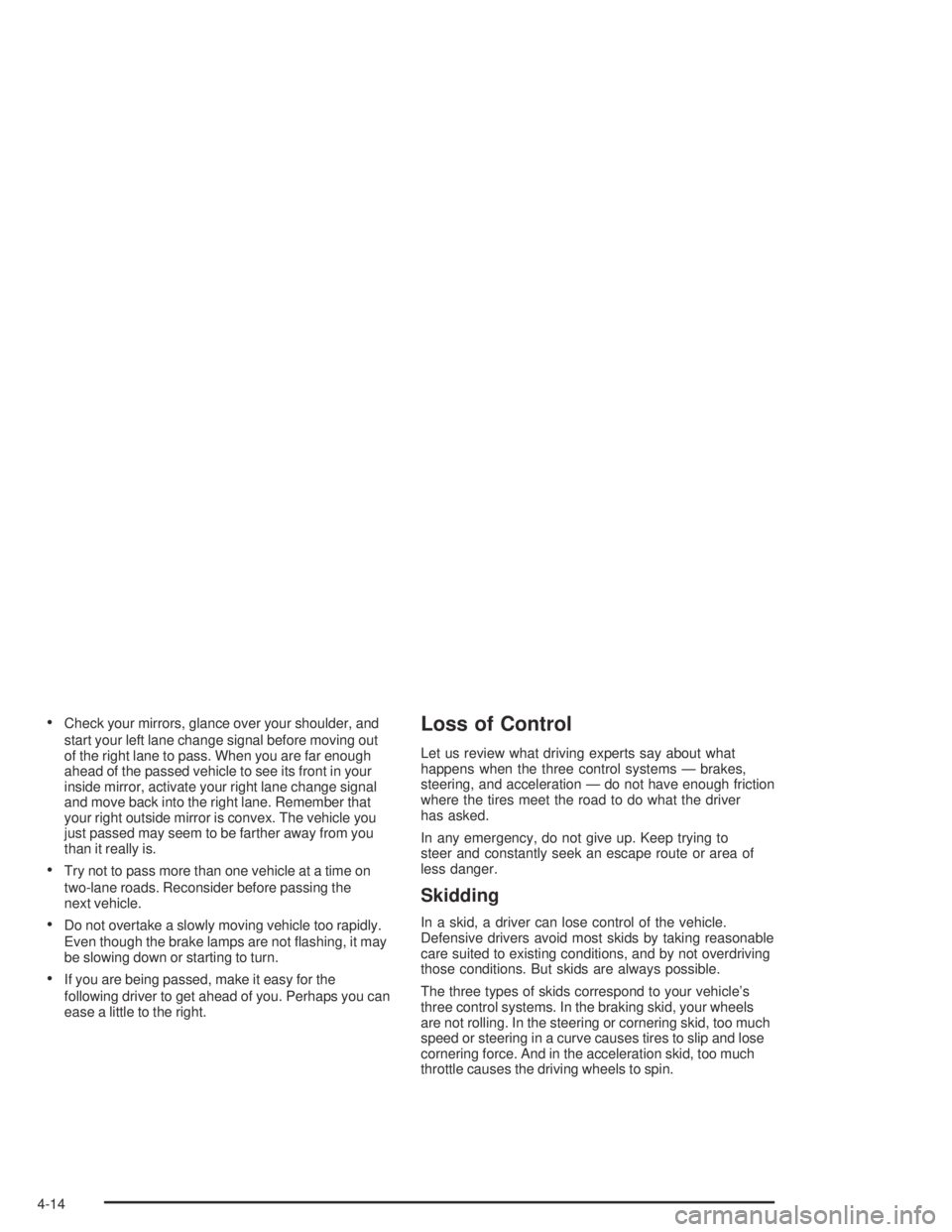
Check your mirrors, glance over your shoulder, and
start your left lane change signal before moving out
of the right lane to pass. When you are far enough
ahead of the passed vehicle to see its front in your
inside mirror, activate your right lane change signal
and move back into the right lane. Remember that
your right outside mirror is convex. The vehicle you
just passed may seem to be farther away from you
than it really is.
Try not to pass more than one vehicle at a time on
two-lane roads. Reconsider before passing the
next vehicle.
Do not overtake a slowly moving vehicle too rapidly.
Even though the brake lamps are not �ashing, it may
be slowing down or starting to turn.
If you are being passed, make it easy for the
following driver to get ahead of you. Perhaps you can
ease a little to the right.
Loss of Control
Let us review what driving experts say about what
happens when the three control systems — brakes,
steering, and acceleration — do not have enough friction
where the tires meet the road to do what the driver
has asked.
In any emergency, do not give up. Keep trying to
steer and constantly seek an escape route or area of
less danger.
Skidding
In a skid, a driver can lose control of the vehicle.
Defensive drivers avoid most skids by taking reasonable
care suited to existing conditions, and by not overdriving
those conditions. But skids are always possible.
The three types of skids correspond to your vehicle’s
three control systems. In the braking skid, your wheels
are not rolling. In the steering or cornering skid, too much
speed or steering in a curve causes tires to slip and lose
cornering force. And in the acceleration skid, too much
throttle causes the driving wheels to spin.
4-14
Page 203 of 388
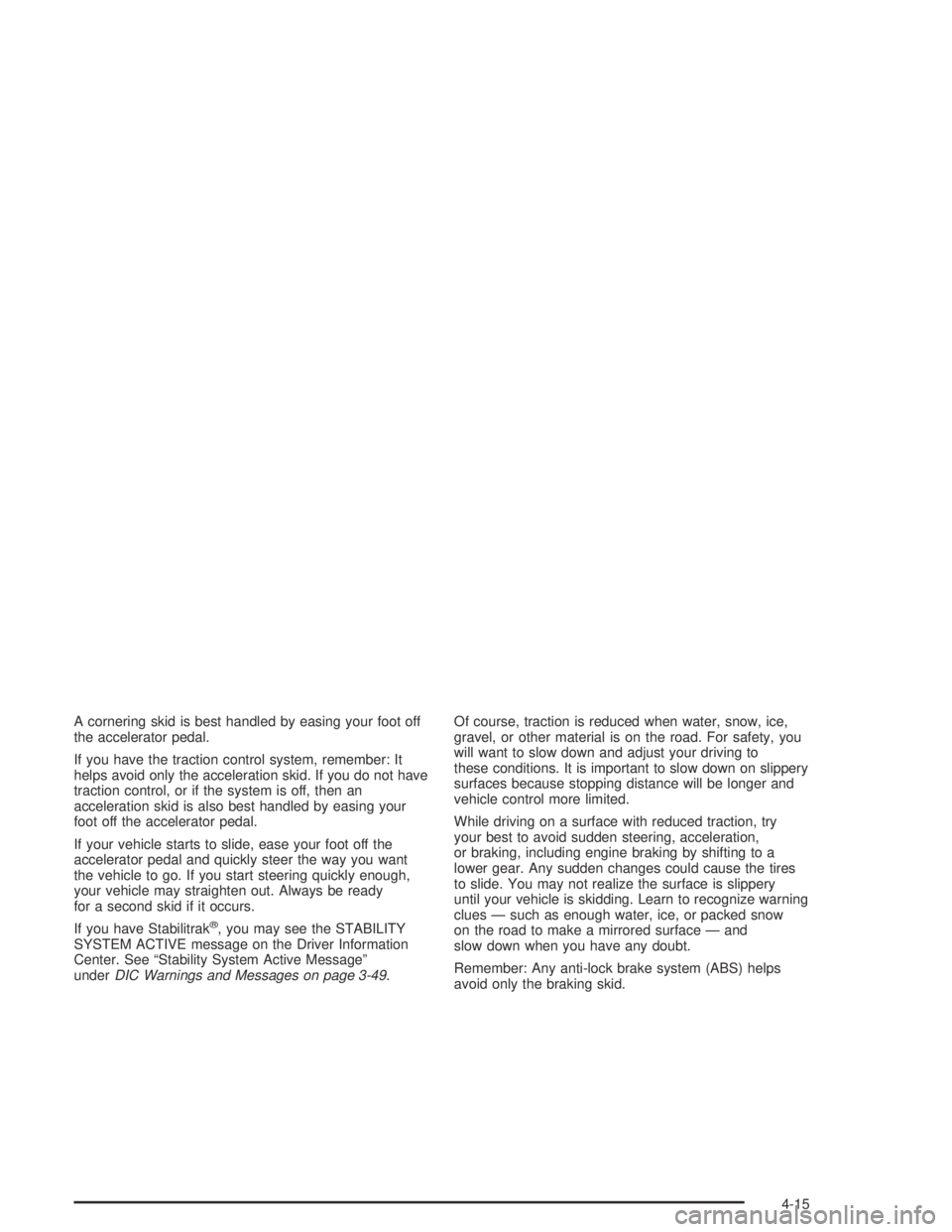
A cornering skid is best handled by easing your foot off
the accelerator pedal.
If you have the traction control system, remember: It
helps avoid only the acceleration skid. If you do not have
traction control, or if the system is off, then an
acceleration skid is also best handled by easing your
foot off the accelerator pedal.
If your vehicle starts to slide, ease your foot off the
accelerator pedal and quickly steer the way you want
the vehicle to go. If you start steering quickly enough,
your vehicle may straighten out. Always be ready
for a second skid if it occurs.
If you have Stabilitrak
®, you may see the STABILITY
SYSTEM ACTIVE message on the Driver Information
Center. See “Stability System Active Message”
underDIC Warnings and Messages on page 3-49.Of course, traction is reduced when water, snow, ice,
gravel, or other material is on the road. For safety, you
will want to slow down and adjust your driving to
these conditions. It is important to slow down on slippery
surfaces because stopping distance will be longer and
vehicle control more limited.
While driving on a surface with reduced traction, try
your best to avoid sudden steering, acceleration,
or braking, including engine braking by shifting to a
lower gear. Any sudden changes could cause the tires
to slide. You may not realize the surface is slippery
until your vehicle is skidding. Learn to recognize warning
clues — such as enough water, ice, or packed snow
on the road to make a mirrored surface — and
slow down when you have any doubt.
Remember: Any anti-lock brake system (ABS) helps
avoid only the braking skid.
4-15
Page 204 of 388
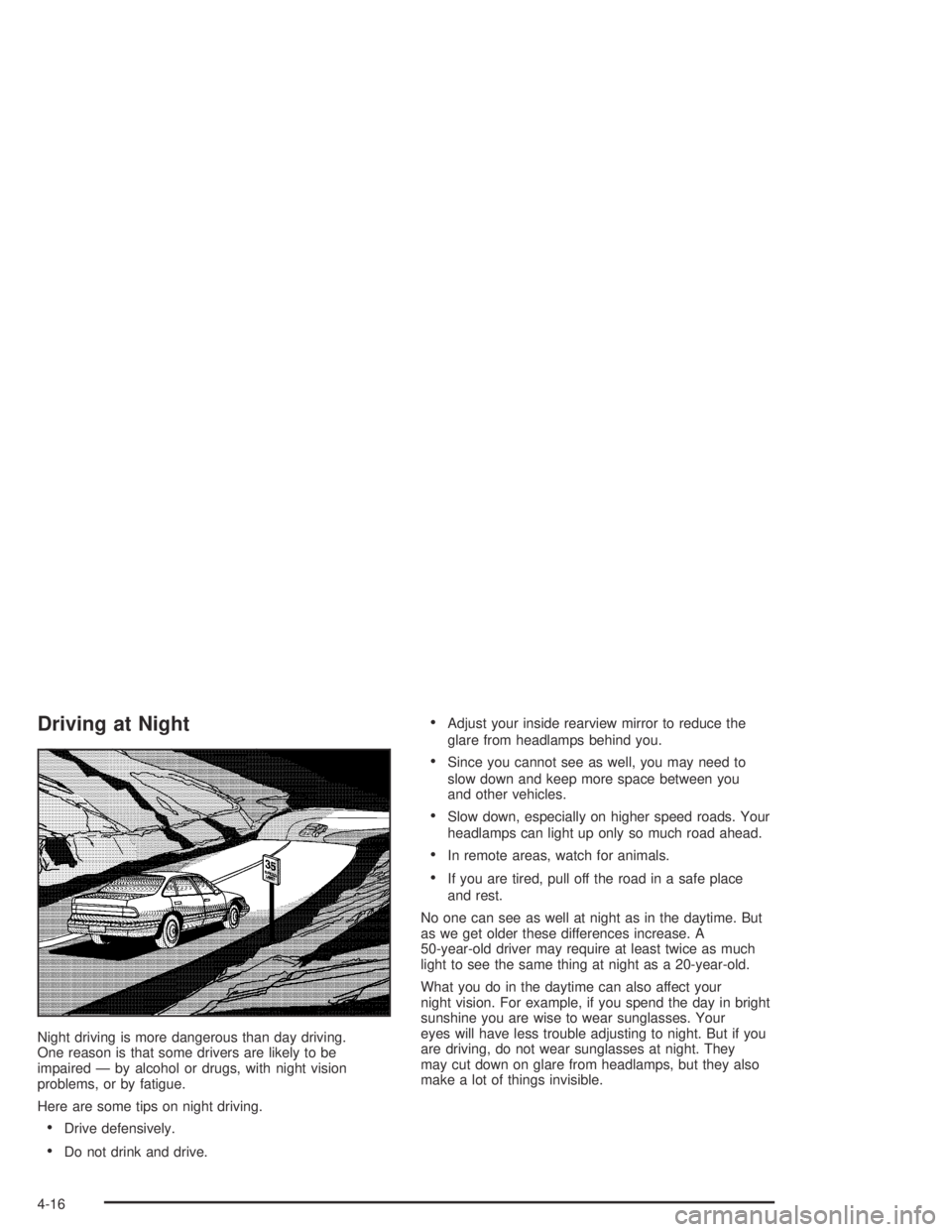
Driving at Night
Night driving is more dangerous than day driving.
One reason is that some drivers are likely to be
impaired — by alcohol or drugs, with night vision
problems, or by fatigue.
Here are some tips on night driving.
Drive defensively.
Do not drink and drive.
Adjust your inside rearview mirror to reduce the
glare from headlamps behind you.
Since you cannot see as well, you may need to
slow down and keep more space between you
and other vehicles.
Slow down, especially on higher speed roads. Your
headlamps can light up only so much road ahead.
In remote areas, watch for animals.
If you are tired, pull off the road in a safe place
and rest.
No one can see as well at night as in the daytime. But
as we get older these differences increase. A
50-year-old driver may require at least twice as much
light to see the same thing at night as a 20-year-old.
What you do in the daytime can also affect your
night vision. For example, if you spend the day in bright
sunshine you are wise to wear sunglasses. Your
eyes will have less trouble adjusting to night. But if you
are driving, do not wear sunglasses at night. They
may cut down on glare from headlamps, but they also
make a lot of things invisible.
4-16
Page 209 of 388
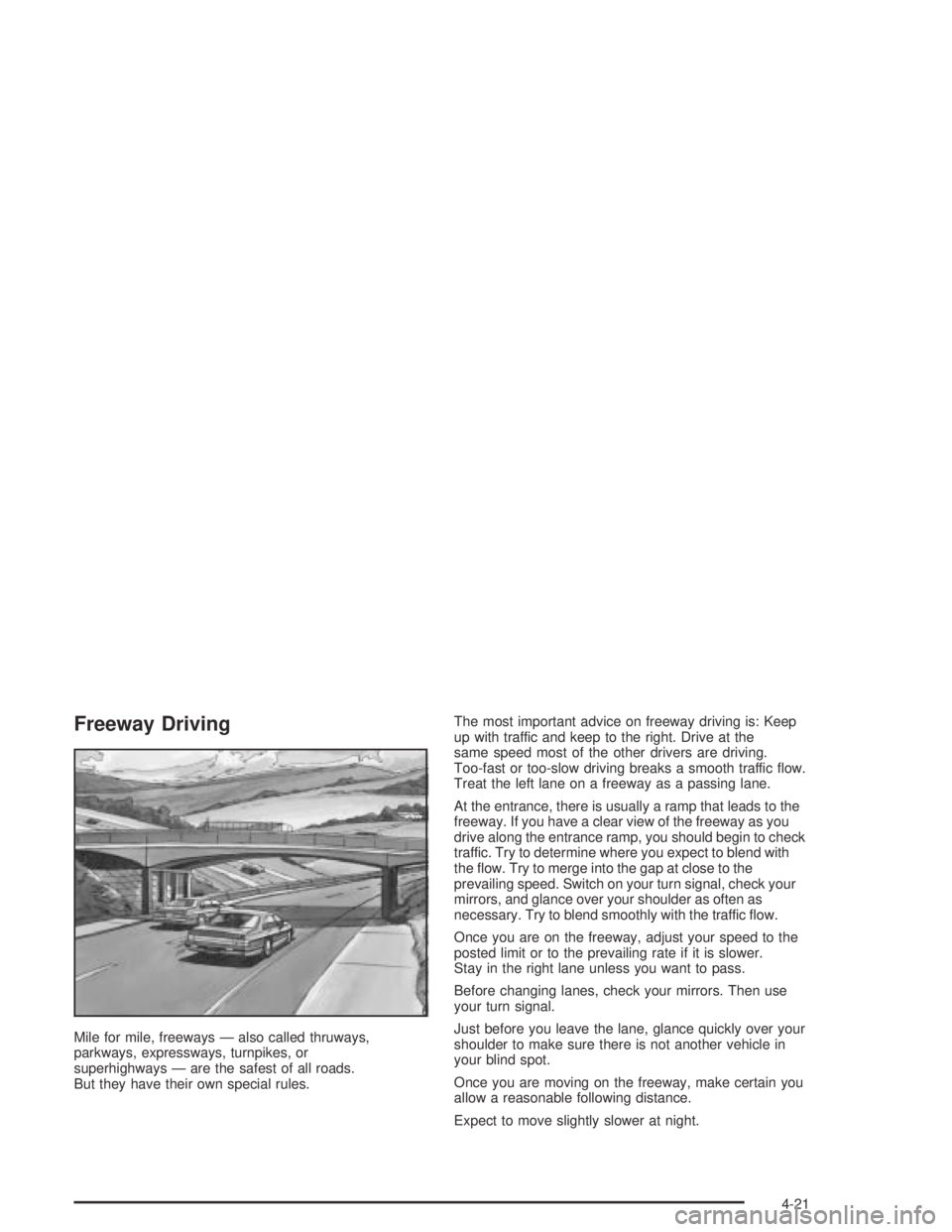
Freeway Driving
Mile for mile, freeways — also called thruways,
parkways, expressways, turnpikes, or
superhighways — are the safest of all roads.
But they have their own special rules.The most important advice on freeway driving is: Keep
up with traffic and keep to the right. Drive at the
same speed most of the other drivers are driving.
Too-fast or too-slow driving breaks a smooth traffic �ow.
Treat the left lane on a freeway as a passing lane.
At the entrance, there is usually a ramp that leads to the
freeway. If you have a clear view of the freeway as you
drive along the entrance ramp, you should begin to check
traffic. Try to determine where you expect to blend with
the �ow. Try to merge into the gap at close to the
prevailing speed. Switch on your turn signal, check your
mirrors, and glance over your shoulder as often as
necessary. Try to blend smoothly with the traffic �ow.
Once you are on the freeway, adjust your speed to the
posted limit or to the prevailing rate if it is slower.
Stay in the right lane unless you want to pass.
Before changing lanes, check your mirrors. Then use
your turn signal.
Just before you leave the lane, glance quickly over your
shoulder to make sure there is not another vehicle in
your blind spot.
Once you are moving on the freeway, make certain you
allow a reasonable following distance.
Expect to move slightly slower at night.
4-21
Page 211 of 388
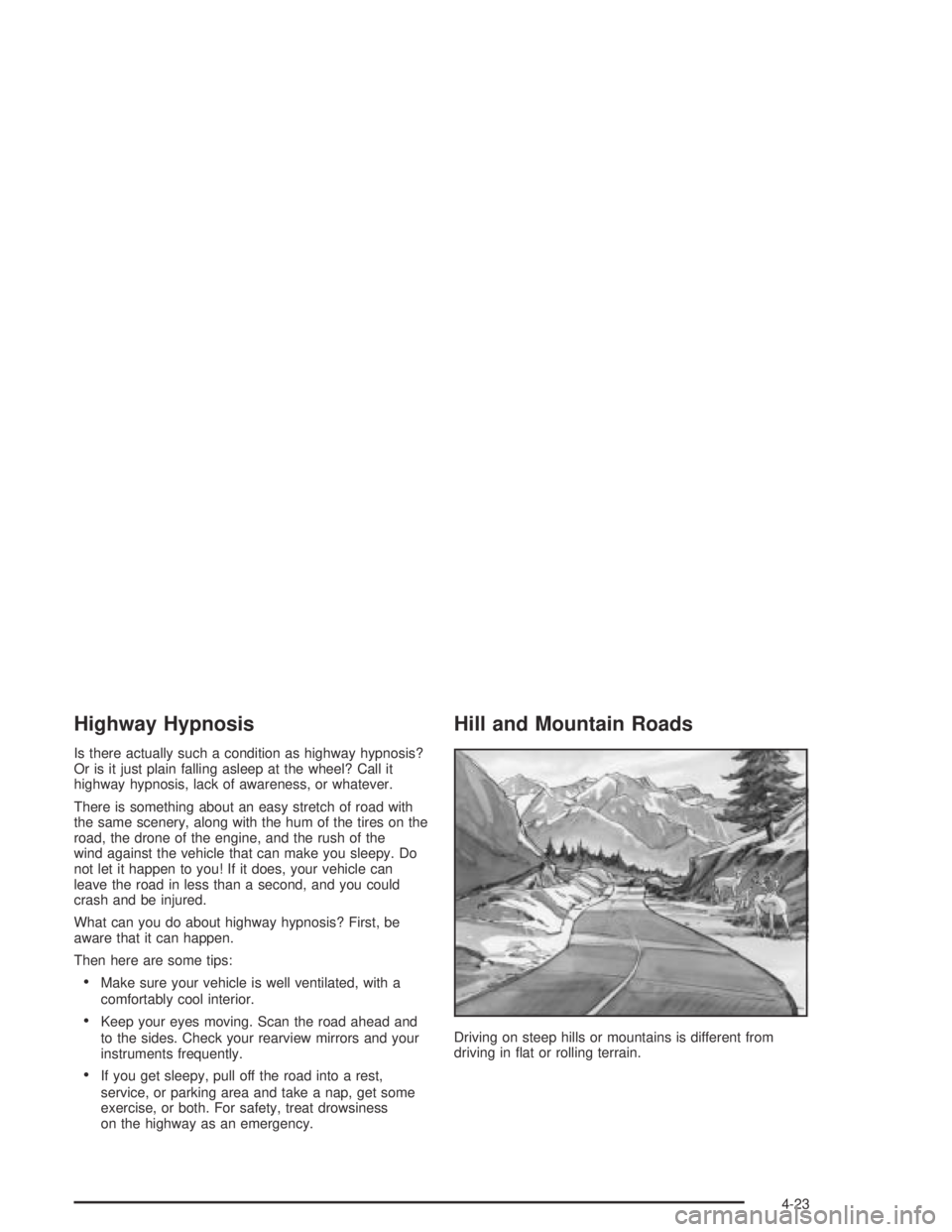
Highway Hypnosis
Is there actually such a condition as highway hypnosis?
Or is it just plain falling asleep at the wheel? Call it
highway hypnosis, lack of awareness, or whatever.
There is something about an easy stretch of road with
the same scenery, along with the hum of the tires on the
road, the drone of the engine, and the rush of the
wind against the vehicle that can make you sleepy. Do
not let it happen to you! If it does, your vehicle can
leave the road in less than a second, and you could
crash and be injured.
What can you do about highway hypnosis? First, be
aware that it can happen.
Then here are some tips:
Make sure your vehicle is well ventilated, with a
comfortably cool interior.
Keep your eyes moving. Scan the road ahead and
to the sides. Check your rearview mirrors and your
instruments frequently.
If you get sleepy, pull off the road into a rest,
service, or parking area and take a nap, get some
exercise, or both. For safety, treat drowsiness
on the highway as an emergency.
Hill and Mountain Roads
Driving on steep hills or mountains is different from
driving in �at or rolling terrain.
4-23
Page 228 of 388
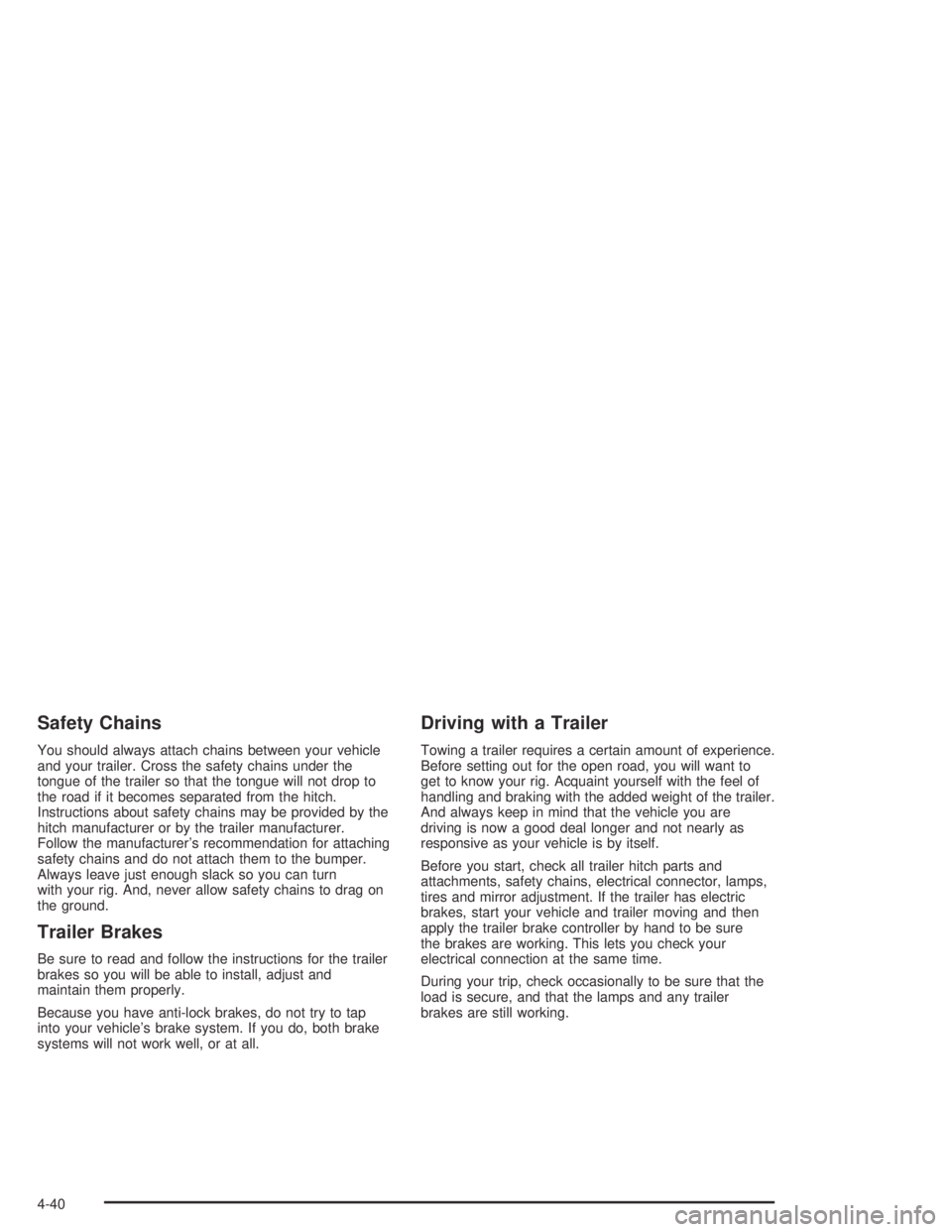
Safety Chains
You should always attach chains between your vehicle
and your trailer. Cross the safety chains under the
tongue of the trailer so that the tongue will not drop to
the road if it becomes separated from the hitch.
Instructions about safety chains may be provided by the
hitch manufacturer or by the trailer manufacturer.
Follow the manufacturer’s recommendation for attaching
safety chains and do not attach them to the bumper.
Always leave just enough slack so you can turn
with your rig. And, never allow safety chains to drag on
the ground.
Trailer Brakes
Be sure to read and follow the instructions for the trailer
brakes so you will be able to install, adjust and
maintain them properly.
Because you have anti-lock brakes, do not try to tap
into your vehicle’s brake system. If you do, both brake
systems will not work well, or at all.
Driving with a Trailer
Towing a trailer requires a certain amount of experience.
Before setting out for the open road, you will want to
get to know your rig. Acquaint yourself with the feel of
handling and braking with the added weight of the trailer.
And always keep in mind that the vehicle you are
driving is now a good deal longer and not nearly as
responsive as your vehicle is by itself.
Before you start, check all trailer hitch parts and
attachments, safety chains, electrical connector, lamps,
tires and mirror adjustment. If the trailer has electric
brakes, start your vehicle and trailer moving and then
apply the trailer brake controller by hand to be sure
the brakes are working. This lets you check your
electrical connection at the same time.
During your trip, check occasionally to be sure that the
load is secure, and that the lamps and any trailer
brakes are still working.
4-40
Page 325 of 388
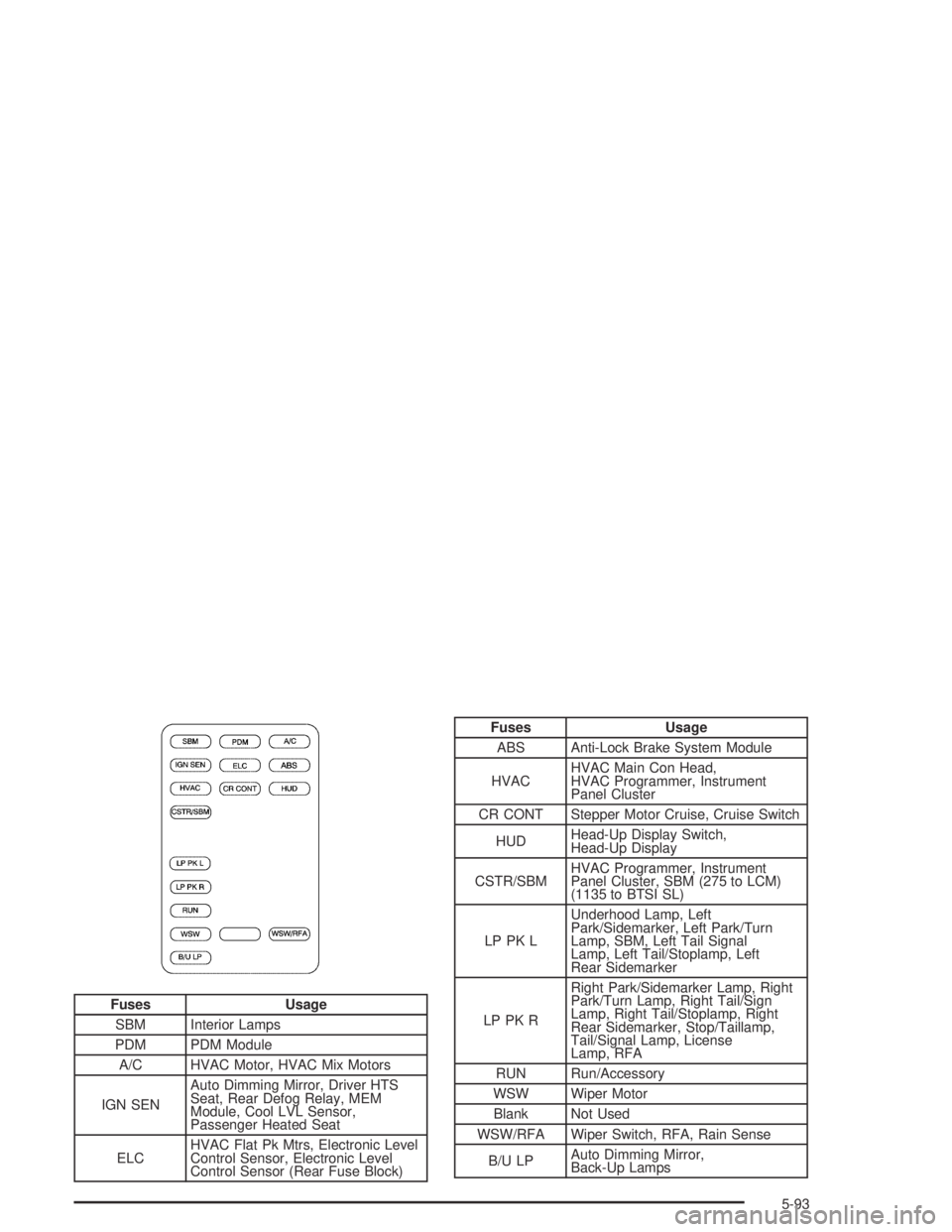
Fuses Usage
SBM Interior Lamps
PDM PDM Module
A/C HVAC Motor, HVAC Mix Motors
IGN SENAuto Dimming Mirror, Driver HTS
Seat, Rear Defog Relay, MEM
Module, Cool LVL Sensor,
Passenger Heated Seat
ELCHVAC Flat Pk Mtrs, Electronic Level
Control Sensor, Electronic Level
Control Sensor (Rear Fuse Block)
Fuses Usage
ABS Anti-Lock Brake System Module
HVACHVAC Main Con Head,
HVAC Programmer, Instrument
Panel Cluster
CR CONT Stepper Motor Cruise, Cruise Switch
HUDHead-Up Display Switch,
Head-Up Display
CSTR/SBMHVAC Programmer, Instrument
Panel Cluster, SBM (275 to LCM)
(1135 to BTSI SL)
LP PK LUnderhood Lamp, Left
Park/Sidemarker, Left Park/Turn
Lamp, SBM, Left Tail Signal
Lamp, Left Tail/Stoplamp, Left
Rear Sidemarker
LP PK RRight Park/Sidemarker Lamp, Right
Park/Turn Lamp, Right Tail/Sign
Lamp, Right Tail/Stoplamp, Right
Rear Sidemarker, Stop/Taillamp,
Tail/Signal Lamp, License
Lamp, RFA
RUN Run/Accessory
WSW Wiper Motor
Blank Not Used
WSW/RFA Wiper Switch, RFA, Rain Sense
B/U LPAuto Dimming Mirror,
Back-Up Lamps
5-93
Page 383 of 388
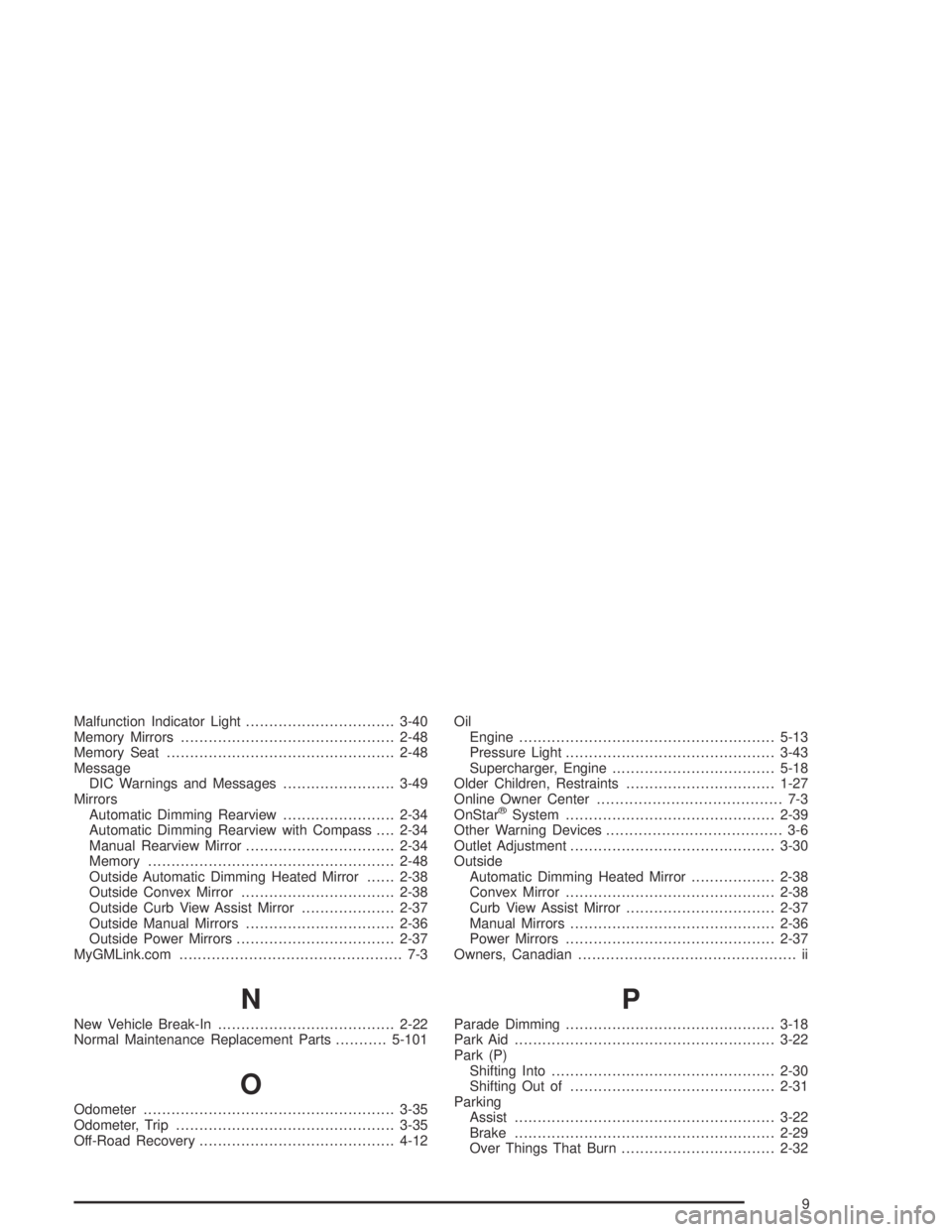
Malfunction Indicator Light................................3-40
Memory Mirrors..............................................2-48
Memory Seat.................................................2-48
Message
DIC Warnings and Messages........................3-49
Mirrors
Automatic Dimming Rearview........................2-34
Automatic Dimming Rearview with Compass....2-34
Manual Rearview Mirror................................2-34
Memory.....................................................2-48
Outside Automatic Dimming Heated Mirror......2-38
Outside Convex Mirror.................................2-38
Outside Curb View Assist Mirror....................2-37
Outside Manual Mirrors................................2-36
Outside Power Mirrors..................................2-37
MyGMLink.com................................................ 7-3
N
New Vehicle Break-In......................................2-22
Normal Maintenance Replacement Parts...........5-101
O
Odometer......................................................3-35
Odometer, Trip...............................................3-35
Off-Road Recovery..........................................4-12Oil
Engine.......................................................5-13
Pressure Light.............................................3-43
Supercharger, Engine...................................5-18
Older Children, Restraints................................1-27
Online Owner Center........................................ 7-3
OnStar
®System.............................................2-39
Other Warning Devices...................................... 3-6
Outlet Adjustment............................................3-30
Outside
Automatic Dimming Heated Mirror..................2-38
Convex Mirror.............................................2-38
Curb View Assist Mirror................................2-37
Manual Mirrors............................................2-36
Power Mirrors.............................................2-37
Owners, Canadian............................................... ii
P
Parade Dimming.............................................3-18
Park Aid........................................................3-22
Park (P)
Shifting Into................................................2-30
Shifting Out of............................................2-31
Parking
Assist........................................................3-22
Brake........................................................2-29
Over Things That Burn.................................2-32
9
Page 384 of 388
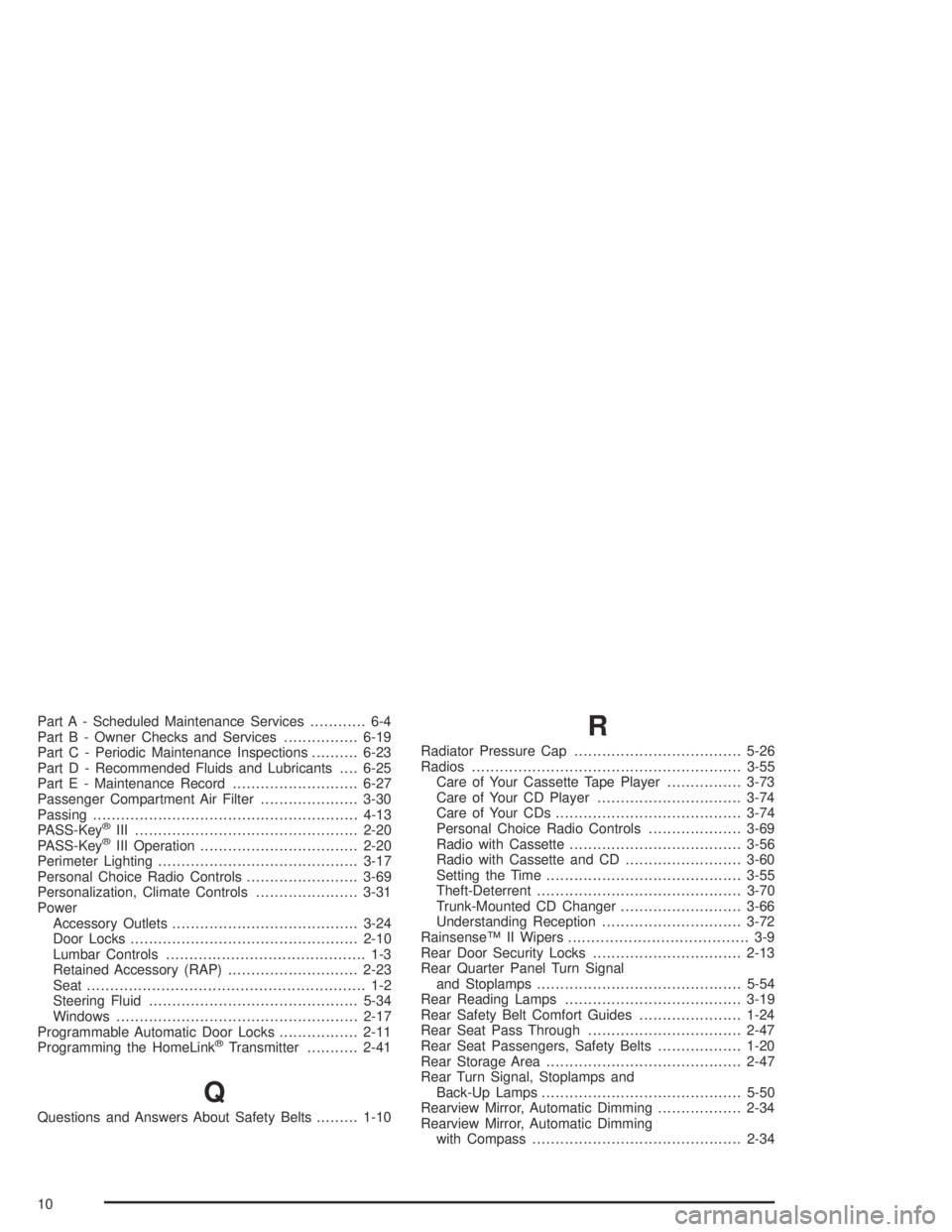
Part A - Scheduled Maintenance Services............ 6-4
Part B - Owner Checks and Services................6-19
Part C - Periodic Maintenance Inspections..........6-23
Part D - Recommended Fluids and Lubricants....6-25
Part E - Maintenance Record...........................6-27
Passenger Compartment Air Filter.....................3-30
Passing.........................................................4-13
PASS-Key
®III ................................................2-20
PASS-Key®III Operation..................................2-20
Perimeter Lighting...........................................3-17
Personal Choice Radio Controls........................3-69
Personalization, Climate Controls......................3-31
Power
Accessory Outlets........................................3-24
Door Locks.................................................2-10
Lumbar Controls........................................... 1-3
Retained Accessory (RAP)............................2-23
Seat............................................................ 1-2
Steering Fluid.............................................5-34
Windows....................................................2-17
Programmable Automatic Door Locks.................2-11
Programming the HomeLink
®Transmitter...........2-41
Q
Questions and Answers About Safety Belts.........1-10
R
Radiator Pressure Cap....................................5-26
Radios..........................................................3-55
Care of Your Cassette Tape Player................3-73
Care of Your CD Player...............................3-74
Care of Your CDs........................................3-74
Personal Choice Radio Controls....................3-69
Radio with Cassette.....................................3-56
Radio with Cassette and CD.........................3-60
Setting the Time..........................................3-55
Theft-Deterrent............................................3-70
Trunk-Mounted CD Changer..........................3-66
Understanding Reception..............................3-72
Rainsense™ II Wipers....................................... 3-9
Rear Door Security Locks................................2-13
Rear Quarter Panel Turn Signal
and Stoplamps............................................5-54
Rear Reading Lamps......................................3-19
Rear Safety Belt Comfort Guides......................1-24
Rear Seat Pass Through.................................2-47
Rear Seat Passengers, Safety Belts..................1-20
Rear Storage Area..........................................2-47
Rear Turn Signal, Stoplamps and
Back-Up Lamps...........................................5-50
Rearview Mirror, Automatic Dimming..................2-34
Rearview Mirror, Automatic Dimming
with Compass.............................................2-34
10
Page 385 of 388
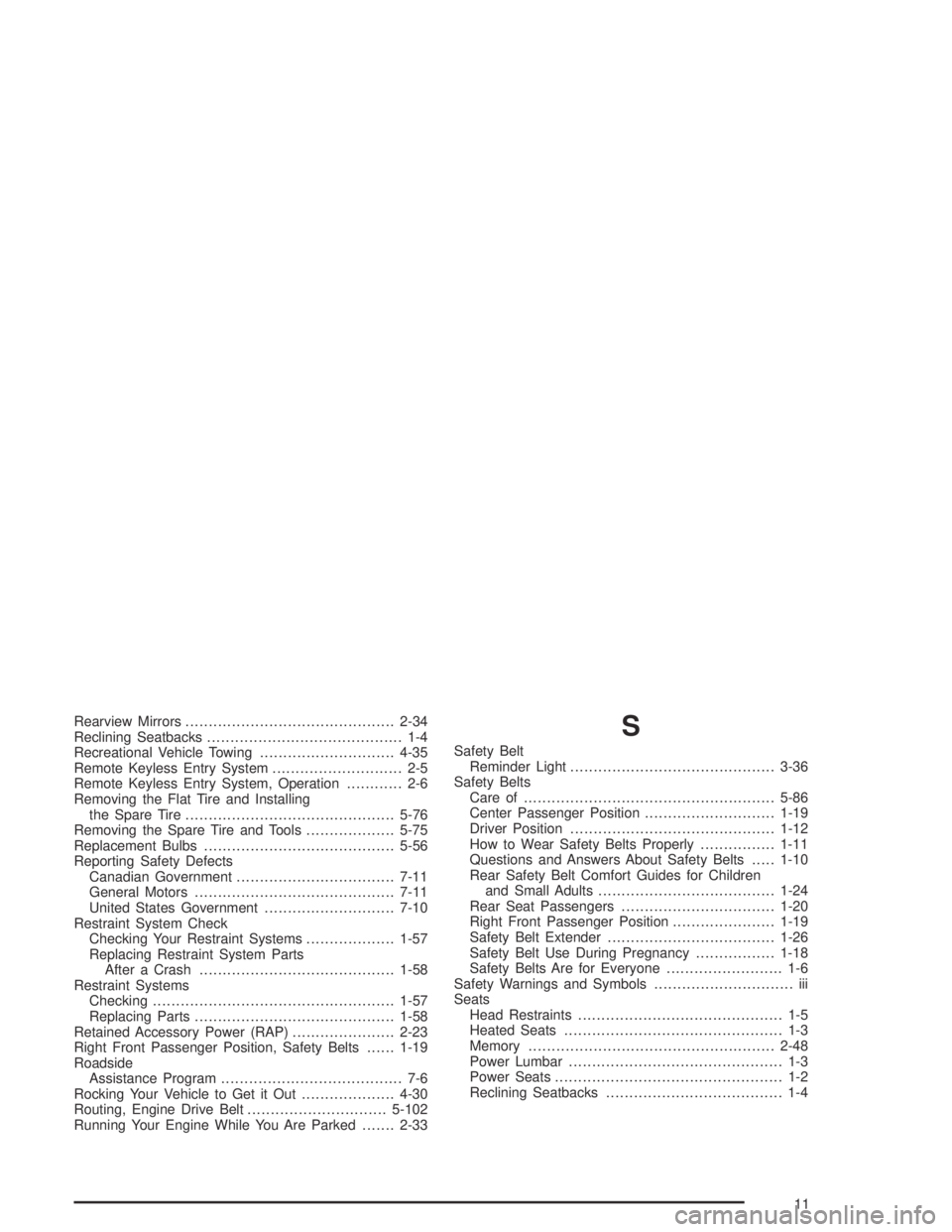
Rearview Mirrors.............................................2-34
Reclining Seatbacks.......................................... 1-4
Recreational Vehicle Towing.............................4-35
Remote Keyless Entry System............................ 2-5
Remote Keyless Entry System, Operation............ 2-6
Removing the Flat Tire and Installing
the Spare Tire.............................................5-76
Removing the Spare Tire and Tools...................5-75
Replacement Bulbs.........................................5-56
Reporting Safety Defects
Canadian Government..................................7-11
General Motors...........................................7-11
United States Government............................7-10
Restraint System Check
Checking Your Restraint Systems...................1-57
Replacing Restraint System Parts
After a Crash..........................................1-58
Restraint Systems
Checking....................................................1-57
Replacing Parts...........................................1-58
Retained Accessory Power (RAP)......................2-23
Right Front Passenger Position, Safety Belts......1-19
Roadside
Assistance Program....................................... 7-6
Rocking Your Vehicle to Get it Out....................4-30
Routing, Engine Drive Belt..............................5-102
Running Your Engine While You Are Parked.......2-33S
Safety Belt
Reminder Light............................................3-36
Safety Belts
Care of......................................................5-86
Center Passenger Position............................1-19
Driver Position............................................1-12
How to Wear Safety Belts Properly................1-11
Questions and Answers About Safety Belts.....1-10
Rear Safety Belt Comfort Guides for Children
and Small Adults......................................1-24
Rear Seat Passengers.................................1-20
Right Front Passenger Position......................1-19
Safety Belt Extender....................................1-26
Safety Belt Use During Pregnancy.................1-18
Safety Belts Are for Everyone......................... 1-6
Safety Warnings and Symbols.............................. iii
Seats
Head Restraints............................................ 1-5
Heated Seats............................................... 1-3
Memory.....................................................2-48
Power Lumbar.............................................. 1-3
Power Seats................................................. 1-2
Reclining Seatbacks...................................... 1-4
11